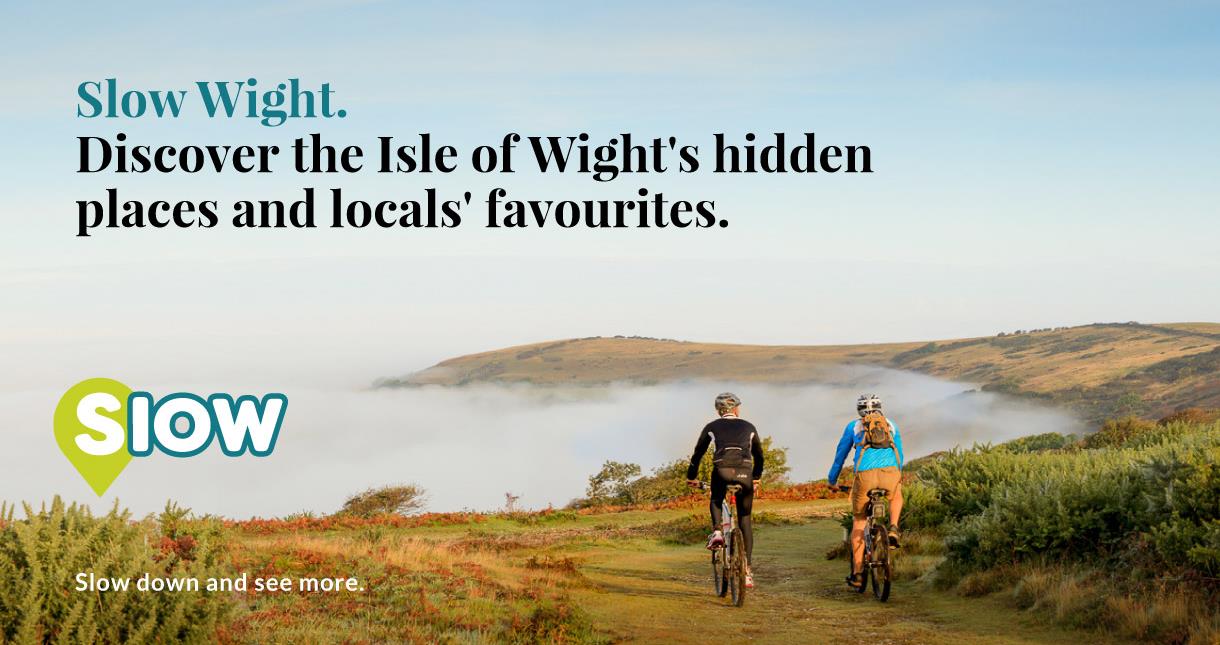When it comes to exploring the Isle of Wight, you will be surprised to find that your car is not essential to travel around our island. With an excellent bus service, a frequent rail line along the east side of the Isle of Wight and an extensive network of walking routes and cycle paths, car-free walking adventures are feasible and extremely enjoyable. Slow travel on the Isle of Wight is about taking your time, embracing unhurried walking experiences, stopping in an area and discovering hidden gems, as well as truly connecting with local culture. Whether you follow scenic walking trails through countryside and along the coast with our walking route maps, a walking holiday on the Isle of Wight offers the perfect setting for slow walking escape, with unforgettable views and island charm.
The simple idea is that the slow guide will give you hints and pointers to get out and really explore our island. Across the eleven touring routes, each based in a different geographical area of our island, you may discover hidden beaches and nature reserves, or maybe one of our local producers who grow a wide variety of mouth-watering fruit, veg, beer, gin and much more.
.png)
Slow travel Isle of Wight walking routes
The routes are designed to be largely accessible by foot or bike (which you can hire whilst you’re here), but you can also benefit from using the bus or rail network if you’re feeling tired. The routes are linear but by no means prescriptive: at a push you could ‘do’ each of these routes in a single day but that would probably be missing the point - rest stops and overnight stays are highlighted and encouraged!
Why slow travel?
If you slow down, you might not see as much of an area as you would in a car, but you will experience more of what you do visit. So, leave the car at home, come over as a foot passenger on the ferry across the Solent and step out onto an island where the pace of life is less hectic than what you may have left behind. Welcome to slow wight.

The slow travel guide
Discover the magic of slow travel with eleven stunning walking routes on the Isle of Wight. Each route offers its own adventure, winding through charming villages, breathtaking coastal views and peaceful countryside surroundings. Use the walking routes map below to plan your journey or explore each individual route in detail and find your perfect walk on our island.
Route 1 - East Cowes to Wootton
After crossing the Solent and making landfall at either Cowes, Ryde or Fishbourne, it’s tempting to head straight off into the Isle of Wight’s hinterland. Don’t make that mistake: this underrated part of our island has some of its most appealing ‘slow’ attractions including a royal residence, steam railway and Benedictine abbey.

Route 2 - Ryde to Seaview
Surrounded by an attractive landscape of rolling hills and vast sandy beaches, Ryde is an attractive town that is increasingly establishing a reputation for the quirky and unexpected. One of the popular access routes to our island, it is easy to forget about where you dock but take your time and explore and you’ll find one of the best beaches in the UK.

Route 3 - Seaview to Bembridge (The Isle of Bembridge)
As recently as the 16th century, Bembridge was almost an island, all but cut off from the rest of the Isle of Wight by the River Yar. Some 1,500 years earlier the river and estuary were deep enough for a harbour at Brading Haven, where Roman trading vessels could moor. Yet by the time the Tudors came to the throne, it had begun to silt up, a process later completed by the Victorians who drained the land for grazing. The Isle of Bembridge was no more but now joined to the rest of the Isle of Wight by a soggy marshland.

Route 4 - Brading to Godshill via Adgestone and Arreton
You’ll discover some of our island’s finest produce along this route, from delicious homemade cakes to English wine and just about anything that is edible flavoured with garlic. You can also find some hauntingly tranquil walking routes and discover that some of the best places for spotting wildlife include roadside verges and disused quarries.

Route 5 - Godshill to Shanklin via Wroxall
This area of our island is often overlooked but is home to real showcase of unique attractions which emphasise our island as a whole. Sprawling farmland and towering hills frame this spot, but the natural valleys mean a relatively flat route can be enjoyed while soaking up from marvels of human achievement – a sprawling manor house partly destroyed in the war, a model village with meticulous manage topiary, and a farm home to over 100 rehomed donkeys.

Route 6 – Yaverland, Sandown & Shanklin
The magnificent sands of Sandown Bay dominate the east coast of the Isle of Wight. This is where you will find the epicentre of our island’s traditional, bucket and spade tourism industry with good reason. The uninterrupted sandy beach stretches for 5 miles yet how many people know there is more to the beach than deckchairs and sunshine?
Peer beyond the crowds and you will discover that wildlife is fighting its corner in this part of our island, and you don’t need to be an expert to discover natural wonders from a time long before ice-cream.

Route 7 – Ventnor to Niton via Undercliff and Blackgang
This route will take you from sea level to the highest points of our island and will show you how to slither down to hidden beaches. You’ll see how our island coastline is changing and be able to explore your way through collapsed cliffs. If all that sounds as though you are heading for the wilds of our island, you are!

Route 8 – Yarmouth to Freshwater and The Needles
The westernmost part of our island offers one of the most delightful coast-to-coast excursions in the UK. This area really highlights the unusual topography of our island; the whole northern edge is tilted into the sea, lifting the chalky south into the air. Like a gigantic iceberg on the precipice of flipping, it creates a dramatic landscape, exaggerated along the River Yar.

Route 9 – Freshwater to Brighstone and Mottistone
The southern reaches of West Wight have always been among the most popular destinations on our island. From Victorian poets sequestered on inspiration seeking retreats to modern day holidaymakers exploring the crumbling coastline, visitors date back to the Stone Age and beyond.

Route 10 – Yarmouth to Newtown
The crossing to Yarmouth from Lymington on the mainland is among the most scenic you could wish for, with the journey accompanied for much of the way by reed beds and – always – striking views of the Needles and Tennyson Down. As you approach our island, look to port (east) and you’ll notice a forested coastline that invites exploration.
The hinterland just to the east of Yarmouth is unlike anywhere else in the Isle of Wight. This is a world of creeks, muddy inlets, unvisited coast, wildlife-rich woodlands and tucked away hamlets. It can feel like a slice of our island that time forgot, appreciated only by those in the know.

Route 11 - Cowes to Carisbrooke
One of the popular routes to access our island, it’s easy to head straight into the centre of to explore but you should soak up the maritime history of Cowes, home to the world’s oldest sailing regatta, before heading inland and working your way to the Plantagenet era castle where King Charles 1 was held before his execution in 1649.


 to add an item to your Itinerary basket.
to add an item to your Itinerary basket.







.png)







.png)






like, follow, share....join in!
Facebook
Twitter
Instagram
YouTube
TikTok
Threads